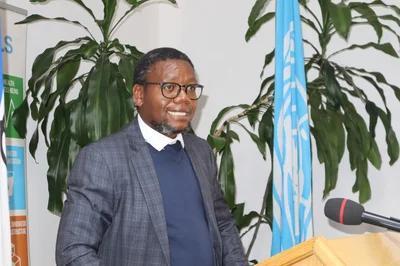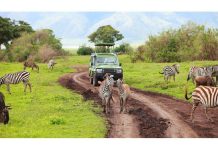Africa-Press – Lesotho. Lesotho has made major progress in fighting climate change, as shown in the 2025–2030 Voluntary National Review (VNR) launched last week by the Minister of Finance and Development Planning, Dr. Retšelisitsoe Matlanyane.
The report highlights the country’s dedication to achieving Sustainable Development Goal (SDG) 13 – Climate Action, with six out of eight indicators showing positive change.
During the launch, Dr. Matlanyane emphasised that climate change remains a serious threat for Lesotho, especially with the rising number of droughts, floods, and other extreme weather events. She said the VNR helps Basotho understand how far the country has come and what still needs to be done to build resilience.
Under Target 13.1 in the VNR it is noted that Lesotho has improved its ability to prepare for and respond to disasters. This includes: Early warning systems, the National Disaster Risk Reduction Strategy (2020–2030), and the formation of 93 Village Disaster Management Teams (VDMTs) in high-risk areas.
These efforts help communities deal better with disasters such as floods, snowstorms, and heavy rains.
However, implementing these measures is still a challenge in remote districts like Mokhotlong, Thaba-Tseka, Qacha’s Nek, and parts of Mohale’s Hoek, due to poor roads and limited resources.
According to the Lesotho Vulnerability Assessment Committee (LVAC), more than 1,200 households were affected by climate-related disasters in 2023 and early 2024. These included displacements and even missing persons.
In 2024, Lesotho submitted its second Nationally Determined Contribution (NDC), where it committed to cutting greenhouse gas emissions by 6% unconditionally and 18% conditionally by 2030. This plan is backed by: A new National Adaptation Plan (NAP), a Long-Term Climate Strategy, and ongoing efforts to control emissions.
Mosuoe Letuma, Principal Meteorologist at the Ministry of Environment and Forestry, said it is important for Basotho to understand and adapt to the climate risks they face.
“We already have a risk reduction strategic plan for 2020 to 2030, which we revise regularly through the Disaster Management Authority (DMA),” he said.
He pointed out that in the first National Strategic Development Plan (NSDP), climate change was treated as a separate chapter, which did not work well. “Now, in NSDP II, climate change is treated as a cross-cutting issue, because there is no sector that is not affected by it.”
Letuma also mentioned the need to include climate alignment as part of budget planning. “We are working on a Climate Change Bill, which we hope to secure funding for.”
While Lesotho emits little compared to larger countries, he urged everyone to act in reducing emissions.
Despite all the efforts, emissions increased by 20.4% between 2005 and 2017, mainly due to higher residential energy use and farming. The country has submitted four national greenhouse gas (GHG) inventories, but still faces challenges with data gaps and weak monitoring.
Improving Monitoring, Reporting, and Verification (MRV) is now a top priority, especially in the energy and agriculture sectors.
Climate education is also gaining ground. It is now part of: The Education Sector Plan (2016–2026), and the National Curriculum Framework, with lessons on climate change taught in primary and secondary schools.
Some colleges also offer courses on environmental and energy topics. A creative method used in Lesotho is involving comedians and entertainers to raise awareness in local languages. These fun and engaging campaigns help people better understand climate issues.
However, more work is needed in training teachers and developing tools to measure climate knowledge.
Between 2021 and 2024, Lesotho successfully raised over US$100 million in climate finance. This includes:
US$55.6 million from the Green Climate Fund,
US$30.7 million from the Least Developed Countries Fund,
US$10 million from the World Bank, and
Additional support from the European Union.
These funds have gone into clean energy projects, adaptation efforts, and strengthening institutions. However, there are still challenges in tracking and reporting the use of these funds. To fix this, Lesotho plans to introduce a National Climate Finance Dashboard.
In 2024, the country submitted its Long-Term Climate Change Vision, aiming to reach net-zero emissions and build climate-resilient development.
Adaptation priorities are clearly outlined in:
The NDCs,
The draft NAP, and
Sector strategies, especially in water and sanitation.
Still, a major problem is the lack of coordination between climate adaptation and disaster risk reduction (DRR). This weakens the effectiveness of national efforts.
To address this, the VNR recommends, stronger coordination across all levels of government, better capacity at the local level, and improved systems for monitoring and evaluating climate actions.
Lesotho has also made progress in weather forecasting and research, with support from the Global Environment Facility (GEF) and the Adaptation Fund. Achievements include: Automated weather stations, Skilled personnel, and access to global forecasting tools—giving communities more time to prepare for disasters.
A major milestone is the launch of the Disaster Risk Financing Strategy (2024–2029). This strategy shifts the focus from responding to disasters to preparing for them financially. It aims to protect vulnerable people and help the government manage its budget better during climate crises.
Although Lesotho is a Least Developed Country (LDC) with low emissions, it remains highly exposed to climate risks. According to the 2021 Climate Risk Index, Lesotho ranks 77th globally, showing how serious the threat is.
Still, the progress highlighted in the VNR proves that Lesotho is stepping up. From disaster preparedness and education to smart investments and planning, the country is laying a strong foundation for a safer, more resilient future.
For More News And Analysis About Lesotho Follow Africa-Press






